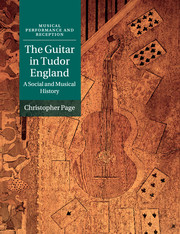Book contents
- Frontmatter
- Dedication
- Contents
- List of figures
- List of tables
- List of music examples
- Acknowledgments
- Note on music examples
- List of abbreviations
- Introduction
- 1 Imagery
- 2 Who owned a gittern?
- 3 The gittern trade
- 4 ‘An instruction to the Gitterne’
- 5 Sounding strings
- 6 The gittern and Tudor song
- 7 Thomas Whythorne: the autobiography of a Tudor guitarist
- Conclusion
- Appendix A The terms ‘gittern’ and ‘cittern’
- Appendix B References to gitterns from 1542 to 1605
- Appendix C The probate inventory of Dennys Bucke (1584)
- Appendix D Octave strings on the fourth and third course
- Appendix E The fiddle tunings of Jerome of Moravia, swept strings and the guitar
- Appendix F The mandore and the wire-strung gittern
- Appendix G The ethos of the guitar in sixteenth-century France
- Appendix H Raphe Bowle
- Bibliography
- Index
5 - Sounding strings
Published online by Cambridge University Press: 05 June 2016
- Frontmatter
- Dedication
- Contents
- List of figures
- List of tables
- List of music examples
- Acknowledgments
- Note on music examples
- List of abbreviations
- Introduction
- 1 Imagery
- 2 Who owned a gittern?
- 3 The gittern trade
- 4 ‘An instruction to the Gitterne’
- 5 Sounding strings
- 6 The gittern and Tudor song
- 7 Thomas Whythorne: the autobiography of a Tudor guitarist
- Conclusion
- Appendix A The terms ‘gittern’ and ‘cittern’
- Appendix B References to gitterns from 1542 to 1605
- Appendix C The probate inventory of Dennys Bucke (1584)
- Appendix D Octave strings on the fourth and third course
- Appendix E The fiddle tunings of Jerome of Moravia, swept strings and the guitar
- Appendix F The mandore and the wire-strung gittern
- Appendix G The ethos of the guitar in sixteenth-century France
- Appendix H Raphe Bowle
- Bibliography
- Index
Summary
Much of the music performed on the guitar in Tudor England was probably spontaneous and ephemeral: the result of a request to play, as it was for Robert Langham, or the desire to make an impression, as it was for Mendax who mingled his music with tall stories about Florida. On such occasions, music requiring a largely or exclusively strummed technique may often have seemed the most convivial kind to employ. Since guitars were commonly equipped with only four courses the string-array was compact and easy to sweep for an impromptu galliard, an accompaniment for a song or a chord sequence like ‘passamezzo antico’ or ‘romanesca’. This is the kind of playing that the renaissance guitar was especially set up to provide, inside as well as out. Insofar as the internal bracing of sixteenthcentury guitars can be inferred from later examples it was simpler than the bracing of a lute, comprising essentially one brace on either side of the sound-hole with a correspondingly thicker soundboard to resist the pull of the strings. The soundboard area above and below the bridge was therefore akin to a membrane; flexing in all directions it responded more quickly to the initial jolt that set the string(s) in motion. The rhythm of the strumming patterns would, as a result, and as experiment shows, be more distinct and idiomatic on the renaissance guitar than on the lute, an effect heightened by the generally smaller size and higher pitch of the former.
To enquire into the currency of strumming techniques during the sixteenth century is partly to ask how later forms of this approach, well documented for the five-course or baroque guitar, emerged; but it is also to investigate whether brushing play may be the renaissance continuation of medieval practices whereby the players of various instruments set all or most of their strings into simultaneous vibration. By these means players had long been able to create a self-accompanying texture of drones, for example, and the most common tunings for the renaissance guitar bear suggestive traces of medieval precedents for fingerboard instruments. There may even be a late survival of such drone accompaniment in ‘The hedgynge hay’, music for a ‘haye’ or company dance (Example 5).
- Type
- Chapter
- Information
- The Guitar in Tudor EnglandA Social and Musical History, pp. 109 - 127Publisher: Cambridge University PressPrint publication year: 2015



